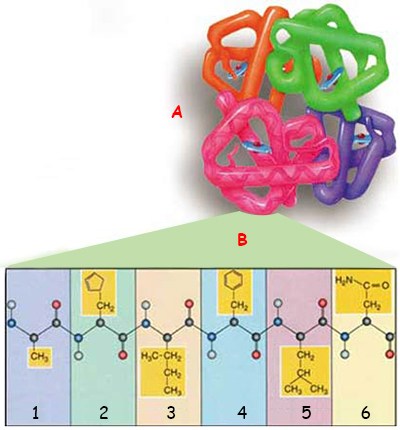 | ||
A. Hemoglobin molecule | ||
1. amino acid 1 | 3. Amino Acid 3 | 5. Amino Acid 5 |
As in all other biochemical structures, the complex structure of hemoglobin is too sensitively balanced to tolerate any randomly occurring mutation. Any accidental chemical change in its structure would immediately turn this valuable protein into a functionless assortment of amino acids. | ||
Darwinism maintains that living things emerged and developed through two natural mechanisms: natural selection and mutation. In fact, however, it is impossible for either of these mechanisms to bring into being a new species or to contribute any new feature to one. (For further information see, Harun Yahya, Darwinism Refuted.) Yet all Darwinian sources tell us how all organisms are the product of these two blind mechanisms. Looked at more carefully, however, there is not the slightest information in these accounts regarding what the mechanisms in question have achieved.
For that reason, therefore, every evolutionist publication you may read or broadcast that you might watch is purely speculative. For example, an article "documenting" how a marine creature must have begun turning into a land dweller through various mutations may be adorned with long sentences and scientific terminology. Yet you can never find in any evolutionist account the answers that really need to be provided: Where and how did the mutations in question arise? What effects and changes did they cause in living things? And by what stages did they come about? That is because evolutionists are well aware that if they did undertake to describe these imaginary stages, they would have to confess that there is no such thing as evolution.
Evolutionists' accounts regarding hemoglobin also conform to this same pattern. You cannot find a single account concerning the alleged evolution of this miraculous molecule that goes any further than pure conjecture.
With its complex structure and the different forms it exhibits in different species, hemoglobin constitutes a serious dilemma for evolutionists. In his book The Great Evolution Mystery, the evolutionist geneticist Gordon Rattray Taylor makes the following admission:
Hemoglobin makes a haphazard appearance in the evolutionary story, appearing in many different phyla. It is found in some species of paramecium (very primitive single-celled creatures known to every school biology class). It is found in worms, mollusks, insects and even in the roots of leguminous vegetables. What it is doing in all these places is largely unexplained. One thing seems clear, that it was invented time and time again, quite independently.30
This fact that Taylor had to admit despite being an evolutionist is actually of the greatest importance. The way that hemoglobin assumes different forms in different species, and the fact that these forms do not fit into any imaginary evolutionist schema, shows that this important molecule was created specially and separately for every group of creatures. The truth that Taylor prefers to describe as "being invented independently" is in fact the truth of creation.
That same fact is detailed by the professor of biochemistry Michael Denton in his book Evolution: A Theory in Crisis:
There is not a trace, at a molecular level, of the traditional evolutionary series: fish to amphibian to reptile to mammal. Incredible, man is closer to lamprey [in his hemoglobin] than are fish!31
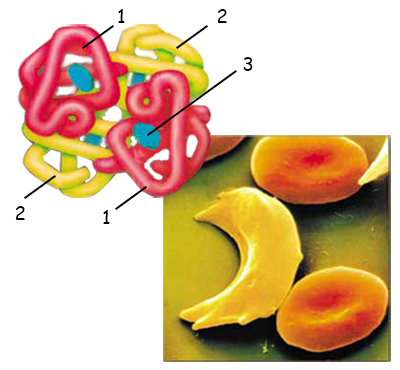 | |
1. Alpha chain | 3. Heme |
At least 120 mutations are necessary in order for the alpha and beta chains that comprise hemoglobin to turn into one another. However, a variation in just one amino acid in this sequence may destroy the blood cells. The cause of sickle cell anemia is just one such mutation. | |
Moreover, as in all other complex organisms, hemoglobin's complex structure is too sensitive to permit any random mutations. If the amino acid sequence that forms the hemoglobin protein is damaged, nothing remains but a useless mass of amino acids. The chances of this molecule coming into possession of this particular amino acid sequence is 1 in 10950—in other words, impossible!
Murray Eden from the Massachusetts Institute of Technology (MIT) comments about this subject:
Hemoglobin has two chains, called alpha and beta. A minimum of 120 mutations would be required to convert alpha to beta. At least 34 of those changes require changeovers in two or three nucleotides. Yet, if a single nucleotide change occurs through mutation, the result ruins the blood and kills the organism!32
If you randomly remove one of the amino acids that constitute hemoglobin, or randomly switch the positions of any two of them, then the protein may either become defective or else lose most or all of its function. The best example of this is sickle cell anemia, which has already been discussed in previous pages. The sole cause for the occurrence of this disease, which has very grave symptoms and for which a cure has not yet been found, is that just two of the amino acids in the sequence constituting hemoglobin have changed places. This disease manifests itself when just two of the 287 amino acids that go to make up hemoglobin are in the wrong place. Nobel Prize-winner Prof. George Wald says this on the subject:
If just one mutational change of any kind was made in it, the hemoglobin would not function properly. For example, the change of one amino acid out of 287 in hemoglobin causes sickle-cell anemia. A glutamic acid unit has been changed to a valine unit—and, as a result, 25% of those suffering with this anemia die.33
Darwinists seek to portray evolution as a theory backed up by powerful evidence, even as the truth. But the fact is that just a single hemoglobin molecule, created by God with an incomparable organization, with its complexity and distribution among species that refute the so-called evolutionary "family tree," is sufficient to put the theory into an impasse.
Two Marwels of Creation: Myoglobin and Hemoglobin | |
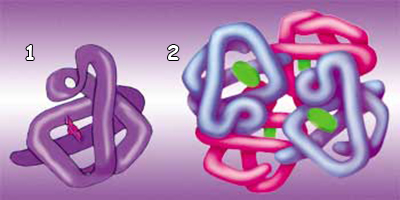 | |
1. Myoglobin | 2. Hemoglobin |
The muscles require less oxygen than other cells in the body. For that reason, a different molecule has been created to distribute oxygen to the muscles. While hemoglobin meets the tissues' needs with the four oxygen molecules it carries, myoglobin gives life to the muscles with its one oxygen molecule. This special organization is a flawless creation of God. | |
Another molecule in the body undertakes the function of carrying oxygen to the muscles. Known as myoglobin, this molecule bears a close structural resemblance to a subunit of hemoglobin, with the distinguishing feature that unlike hemoglobin, it can carry a single oxygen molecule. Myoglobin is specially created for the muscles, because the muscles' oxygen needs are at a lower and specific level. By carrying just one oxygen molecule rather than four, myoglobin is better able to meet the muscles' requirements. However, this does not apply to the other cells in the body. It is essential that the blood carry large amounts of oxygen to the other tissues every moment—which requirement is met by hemoglobin, able to bind four oxygen molecules.
If this distribution of tasks were reversed, then myoglobin would be unable to distribute sufficient oxygen in the body, and hemoglobin would carry too much oxygen to the muscles, which would cause them to exhaust themselves. But neither hemoglobin nor myoglobin carries oxygen to wrong locations in the body. These molecules fully discharge their duties under the command of God, the Almighty Lord of the worlds.
In one verse it is revealed:
Is it other than the religion of God that you desire, when everything in the heavens and Earth, willingly or unwillingly, submits to Him and to Him you will be returned? (Surah Al 'Imran: 83)
Sperm Whale Myoglobin |
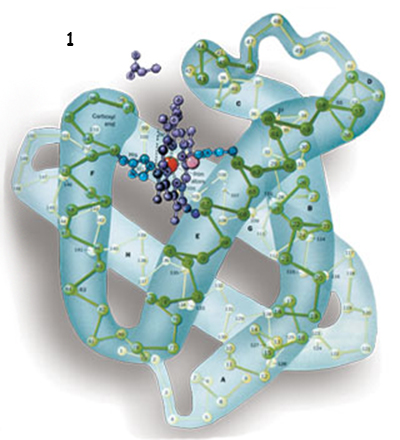 |
1. Sperm whale myoglobin |
The myoglobin molecule is especially created for distributing a single oxygen molecule. Any random interventions in that molecule will damage it and cause it to become nonfunctional. |
The hemoglobin and myoglobin molecules, which perform similar functions, also have the similar molecular features. Their heme groups are no different from one another, and their chains fold in the same way. Evolutionists regarded this similarity as evidence for their theory, and in 1959 declared that these two molecules were "related."
But many structures in nature are molecularly similar. Two molecules differentiated by only a single atom can constitute two entirely different structures. Indeed, even if the atoms are the same and only the bonds between them are different, one molecule can constitute a delicious food and the other can form a tree branch. Hemoglobin and myoglobin are two different molecules with almost identical properties. True, they have similar structures. Yet it is irrational to suggest that hemoglobin "evolved" from myoglobin. Like every other evolutionist claim, this idea is supported by no scientific evidence whatsoever.
Evolutionists claim that by gradual mutations over time, the myoglobin molecule turned into hemoglobin. However, both hemoglobin and myoglobin are special molecules with exceedingly complex structures, performing very complicated chemical processes. Any mutational effect on these molecules—even a small change—can lead to a serious defect in the structure. The sequence in the myoglobin molecule is so sensitive that even a controlled intervention, let alone random mutations, can leave the molecule functionless. In addition, in order to be able to confirm evolutionists' claims, every intermediate stage between myoglobin and hemoglobin would have to be fully functional (and even more beneficial than the stage before it). Yet no such "intermediate form" can be discovered or even described.
In addition to all this, it's erroneous and deceptive to describe hemoglobin as a "developed" form of myoglobin. Myoglobin is a special structure able to carry a single oxygen molecule to nourish the muscles. The fact that it has different properties from hemoglobin and prevents the muscles from over-oxidizing proves that it was created. As stated earlier, the distribution of oxygen to muscles in different quantities than to the other cells is one sign of creation in the human body.
Another major deficiency regarding this claim is the fact that evolutionists have not yet accounted for the origin of the myoglobin, which they claim came to form hemoglobin.
Red blood cells are seemingly aware of the importance of what they do. They constantly travel through the body, identify needs and take precautions when they encounter any situation out of the ordinary. For example, they deposit oxygen when they pass by a hard-working tissue in need of it. They transfer the requisite oxygen to that tissue, pick up the carbon dioxide given off from the oxidation of sugar—the body's basic nutrient—carry the carbon dioxide to the lungs, where they again bind oxygen.
In this exchange, there is a very delicate equilibrium whose details have already been touched on. Wherever there is a need for oxygen, that is where the red blood cells go. They also determine whether there is a need for more red blood cells in the body. The importance of this regulation is crucial. By means of this most careful regulation, your cells and thus, the structures in your body are kept from dying from oxygen starvation.
The changes taking place in your body when you climb a high mountain are also the result of this regulation. The reason is that the higher you go, the harder it is to obtain oxygen. The atmosphere is 21% oxygen, which is more concentrated at lower elevations, due to the higher air pressure. Your lungs will initially have difficulty in adapting to a thinner air. As you ascend, you will become increasingly lethargic, unable to walk, tired and even faint. That is because your body and your brain cannot obtain sufficient oxygen for you to live in the healthy manner you did before.
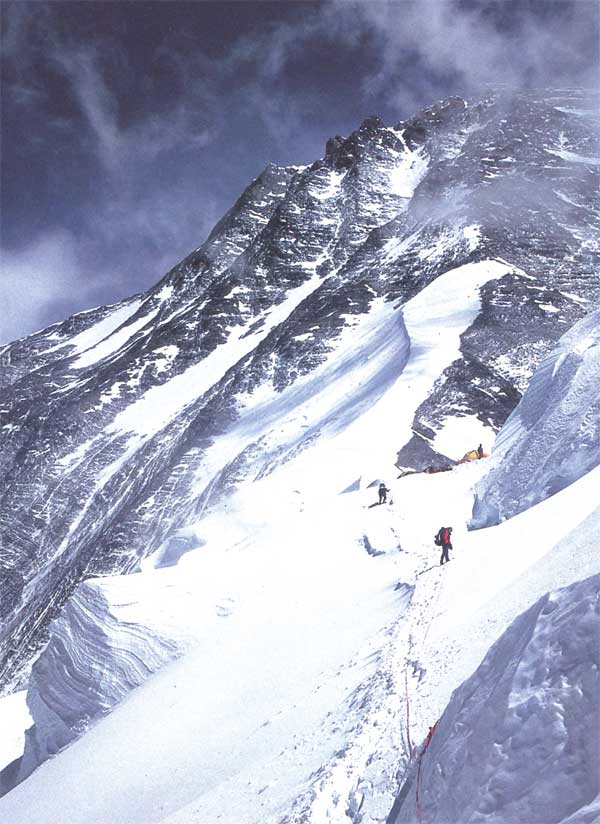 |
When God desires to guide someone, He expands his breast to Islam. When He desires to misguide someone, He makes his breast narrow and constricted as if he were climbing up into the sky. That is how God defiles those who have no faith. ."(Surat al-An'am: 125) |
This problem is resolved, however, thanks to certain support features imparted in the human body by God.
First of all, in such an oxygen-poor environment, your body sounds the alarm. Its first precaution is to check whether the most critical tissues, particularly the brain, are receiving enough oxygen to keep working efficiently. Since the brain uses 20% of all the oxygen taken in the body, it constitutes the main organ the body must protect. The respiratory system and the arteries have been created to perform this function.
Most blood vessels near the heart are equipped with biological "meters" that are very sensitive to any drop in oxygen pressure. This subject, whose details shall be examined in due course, is evidence that God has created all things in great harmony. The lung muscles, stimulated by the nerve cells, increase the breathing rate so that more air reaches the lungs. That is why you find yourself out of breath at high altitudes. Meanwhile, the brain, equipped with its own unique meter, sends messages to the heart, telling it to beat faster and more powerfully so that what oxygen the blood does contain should reach the tissues more quickly.
These measures are all temporary. Were it not for them, you would not be able to long withstand this change in metabolism, and would suffer excessive fatigue. While all this is going on, a more permanent solution occurs behind the scenes.
There is less oxygen available in low-pressure air. To catch this limited oxygen supply, the production of extra red blood cells shortly begins. A few hours after the period of discomfort when you climbed the slopes of a mountain and felt yourself short of breath and even about to faint, your body decides to make permanent adaptive measures for its new environment. A hormone known as erythropoietin starts to be secreted by the kidneys, and partly by the liver. This hormone stimulates the bone marrow to produce more red blood cells. New cells, or the support forces, will enter the bloodstream in 3 to 5 days. But after 15 days, the production of erythropoietin decreases, because your body has adapted to the new high-altitude environment and is no longer in a state of emergency.34
This adaptation is really astonishing. People living between sea level and altitudes of 1,800 meters (5,900 feet) above sea level have around 5 million red blood cells in one drop of their blood; whereas those living at higher altitudes, for example at 4,200 meters (13,780 feet), have some 7 million.
As altitude increases, the red blood cells in the body undergo various chemical changes that enable them to carry more hemoglobin than before. Furthermore, the hemoglobin in the red blood cells begins to be produced in such a way as to load and deposit oxygen more quickly. The other organs and tissues adapt to these most rational precautions in line with the altitude. In order to reduce the level of oxygen carried to the muscles as much as possible, there is a perceptible contraction in muscle size. Thanks to this impeccable system, you adapt to the new environment 15 to 20 days after first feeling a light headache. Your pulse returns to normal and there is no longer any need to take deep breaths to feel comfortable.35
 |
We created you so why do you not confirm the truth? Have you thought about the sperm that you ejaculate? Is it you who create it or are We the Creator? We have decreed death for you and We will not be forestalled. ." (Surat al-waqi'a: 57-60) |
Is it you yourself who undertakes this magnificent control? Many people who reach the fainting stage from a lack of oxygen are quite unaware of these perfect rescue mechanisms within their own bodies. So who provides it? Could such a sensitive system as this have been established over time through random mutations, as Darwinists suggest? The system is so perfectly equipped and behaves so deliberately that any rational person will easily recognize the presence of a Creator here. The organs that carry out red blood cell production, the tissues that take precautionary measures, the heart and veins that cooperate to protect brain function, the stimulants that command enzyme production, the kidney and liver that produce the necessary enzyme, the cells in a constant state of activity and superb coordination, and every protein, every enzyme, every molecule and every atom are all extraordinary. There never arises any confusion in the body.
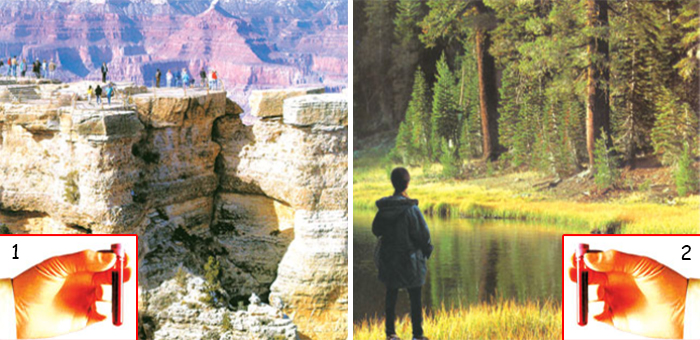 |
1- At higher elevations—at 4,200 meters (13,780 feet), for example—the body will have 7 million red blood cells in one drop of blood. That increased number of red blood cells, much greater than normal, is a precaution taken to ensure the survival of humans in attitudes with low levels of oxygen.2-People living at 1,800 meters (5,900 feet) above sea level have only 5 million red blood cells in one drop of blood. This level in such oxygen-rich regions is sufficient for the body's normal functions. 2- People living at 1,800 meters (5,900 feet) above sea level have only 5 million red blood cells in one drop of blood. This level in such oxygen-rich regions is sufficient for the body's normal functions. |
All this extraordinary activity is the matchless and flawless artistry of God. He has created all things, and rules all places and all things. All things on Earth, and all things within this system, are under His knowledge and control. God is the Ruler, the Director, Who governs all of creation with order and balance (al-Mudabbir). Every work on Earth is His manifestation and obeys Him, because God is the true Lord of the universe. His creation belongs to Him, as does its management.
 |
The brain uses approximately 20% of the oxygen that the lungs take in. When oxygen deficiency occurs, the brain is the first organ that needs to be protected. The heart and respiratory system possess various features specially created to protect the brain as a matter of priority. By means of various precautions, the oxygen taken into the lungs is first sent to the brain via the bloodstream. |
God reveals this major truth in verses:
That is God, your Lord. There is no god but Him, the Creator of everything. So worship Him. He is responsible for everything. Eyesight cannot perceive Him, but He perceives eyesight. He is the All-Penetrating, the All-Aware. (Surat al-An'am: 102-103)
As they near the end of their 120-day odyssey in the bloodstream, red blood cells become less active. As these cells grow older, they become more vulnerable. Their increasingly sensitive cell membrane can tear while passing through narrow points in the circulatory system. Their 8-micrometer diameter is especially damaged while passing through the 3-micrometer diameter of the red splenic pulp. As a result of this constriction, a large amount of red-blood corpuscles are found in the spleen tissue. (When the spleen is removed from the body for any reason, the numbers of abnormal and elderly cells in the blood will rise, since the natural filtering in question does not take place.)
Red blood cells that have come to the end of their lives are broken down by macrophage cells in many regions of the body, particularly in the liver, spleen and bone marrow. During this process, the hemoglobin in the deceased red blood cell is released. Over the next few hours, the macrophages separate the iron from the hemoglobin to be carried in the bloodstream—either to the bone marrow for the production of new red blood cells, or to the iron storage areas in the liver and other tissues, for use at a later date. The macrophages convert the rest of the hemoglobin molecule into a bile pigment.36 In conclusion, the cells' broken-down components are stored in various regions throughout the body for subsequent recycling, with none of them being wasted.
What Happens to Aged Red Blood Cells? | |
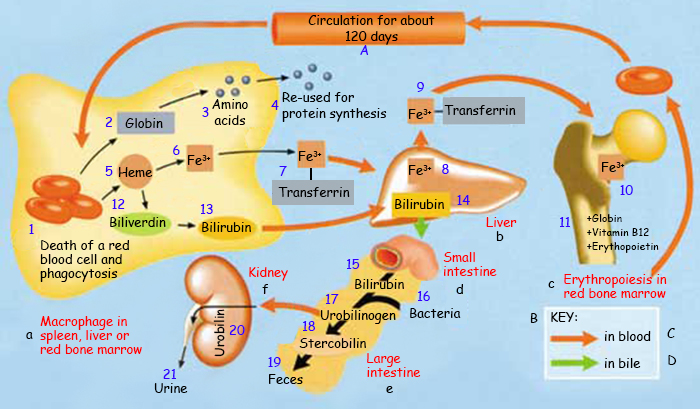 | |
A. Circulation for about 120 days a. Macrophage in spleen, liver or red bone marrow 1. Death of a red blood cell and phagocytosis | 6. Fe3+ |
Red blood cells that come to the end of their lives are broken down by macrophage cells, particularly in the liver, spleen and bone marrow. Macrophages release the iron from the hemoglobin into the blood to be sent to storage. The rest of the hemoglobin molecule is turned into a bile pigment. None of the remnants of the cell are wasted, but are sent to various areas of the body for recycling. | |
Who felt the need for such a storage system, and why? The body's components are mere molecules and atoms. How did they learn to eliminate waste products and store substances of value to the body, such as iron, for later re-use? There is evident planning among them. Clearly, there is a Will that decides that red blood cells should be broken down at specific times, and which entrusts this task to the macrophages. That Will is our Lord God's, Who manifests Himself to us through the works He creates. One way of knowing Him and comprehending His might is to think about the details in the entities He has created. All these marvels we examine in the human body are evidence that we are created by God.
Even the slightest flaw that might arise in this division of labor within the body can lead to severe disorders, and even death. That being so, could all these phenomena have come about gradually, by means of random mutations? Such an event is of course impossible. In the absence of the enzymes that enable iron to be recycled, the body will suffer an iron deficiency. If the hormones that ensure the production of red blood cells fail to do their job, then the level of red cells in the blood will continue to fall. Many systems such as this must work together in close coordination. Therefore, it's essential that all of the system's components need to be present and fully formed in order for it to function. In fact, all the components necessary for the system to function are present in your body. This is just one of the miracles by which God reveals His might.
Therefore, Darwinists' nonsensical claims to the effect that living things came into being gradually and through chance phenomena are completely groundless, as they are on so many other assertions. A red blood cell that carries life to other cells of the body has to exist together with the bone marrow that produces it, the macrophages that break it down, the hemoglobin within it that binds oxygen, the blood plasma in which it's carried, and the blood vessels that transport it to all the cells. It also requires the enzymes and hormones that allow it to multiply and decline in number, and of course the heart, the pump that helps it move in the first place. The absence of just one of these factors will render the red cell useless, serving no purpose at all. It is impossible to speak of coincidences or any imaginary process of "evolution" in the functioning of this perfect system.
 |
Recite: In the Name of your Lord Who created, created man from alaq. Recite : And your Lord is the Most Generous, He Who taught by the pen, taught man what he did not know." (Surat al-'Alaq: 1-5) |
Every process that takes place in the body, every division of labor, and every enzyme that helps perform these functions have all been created by God and are subject to the Creator's commandments. This has been so for every human being who has ever lived, and the evidence of this magnificent creation can also be seen at every moment by every person alive today. Seeking to offer alternative explanations besides creation is a most irrational endeavor, and one condemned to failure.
That is because God's matchless artistry is plain for all to see, as is revealed in these terms in the Qur'an:
God is the Creator of everything and He is Guardian over everything. The keys of the heavens and Earth belong to Him. It is those who reject God's signs who are the losers. (Surat az-Zumar: 62-63)
30 Gordon Rattray Taylor, The Great Evolution Mystery, Secker and Warburg, London, p. 108.
31 "Scientists Speak about Similarities,"http://pathlights.com/ce_encyclopedia/15sim02.htm#Hemoglobin
32 "Wistar Destroys Evolution," http://pathlights.com/ce_encyclopedia/20hist12.htm 
34 Bryce Brown , "The Facts of High Altitude Medicine," http://climb.mountainzone.com/everest/2002/html/dispatch_0505_brown.html
35 Nancy Prichard, "Climbing At New Heights," http://www.altrec.com/published/climb/healthfitness/climbingatnewheights/